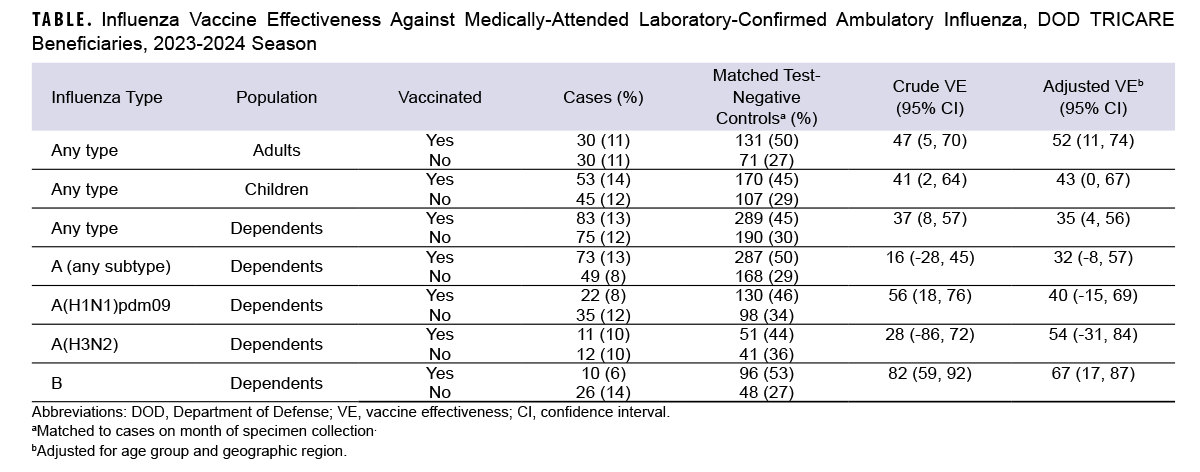The DOD Global Respiratory Pathogen Surveillance Program1 used a matched case-test negative control study design to determine VE estimates against ambulatory influenza among DOD TRICARE beneficiaries. Specimens were collected from October 1, 2023 to February 17, 2024 among individuals with an influenza-like illness medical encounter, then analyzed either at the United States Air Force School of Aerospace Medicine or Landstuhl Regional Medical Center. An ILI encounter was defined as presenting with a fever (≥100.4°F) and cough, fever (≥100.4°F) and two or more additional symptoms (fatigue, body aches, sore throat, headache, sinus congestion, shortness of breath, chills, runny nose, loss of taste or smell, acute respiratory distress) or a physician-diagnosed ILI. The study excluded service members, who were evaluated separately by the Armed Forces Health Surveillance Division.
Cases were individuals with a laboratory-confirmed positive influenza specimen, while controls were those with a specimen testing negative for influenza. An attempt was made to match each case to four controls by the month of specimen collection, but due to control availability, some analyses only had one case to three controls. Vaccination status was determined by utilizing the Aeromedical Services Information Management System or self-reporting through DODGRPSP questionnaires. Individuals were considered vaccinated if they received the vaccine at least 14 days prior to specimen collection, with exclusions for vaccines received within 14 days. Adjusted ORs and 95% CIs were calculated via multivariable logistic regression, adjusting for age group and geographic region. Adjusted VE estimates were computed as (1 - aOR) x 100.

The study identified 158 cases and 479 controls. Adjusted VE estimates for all DOD beneficiaries showed 35% effectiveness (CI: 4, 56) against overall influenza, 32% (CI: -8, 57) against overall influenza A, 40% (CI: -15, 69) against influenza A(H1N1)pdm09, 54% (CI: -31, 84) against influenza A(H3N2), and 67% (CI: 17, 87) against influenza B. For children, the adjusted VE estimate was 43% (CI: 0, 67) against overall influenza, while for adults it was 52% (CI: 11, 74) against overall influenza.
VE estimates suggest statistically significant, low to moderate protection against overall influenza among all DOD TRICARE beneficiaries and adults, as well as against influenza B among all DOD TRICARE beneficiaries. VE estimates against overall influenza for children, overall influenza A for all DOD TRICARE beneficiaries, influenza A(H1N1)pdm09, and influenza A(H3N2) for all DOD TRICARE beneficiaries indicate low to moderate protection, but these results did not reach statistical significance.
Reference
- Kwaah B, Gruner WE, DeMarcus L, et al. Surveillance trends for SARS-CoV-2 and other respiratory pathogens among US military health system beneficiaries, 27 September 2020–2 October 2021. MSMR. 2022;29(7):2-10.